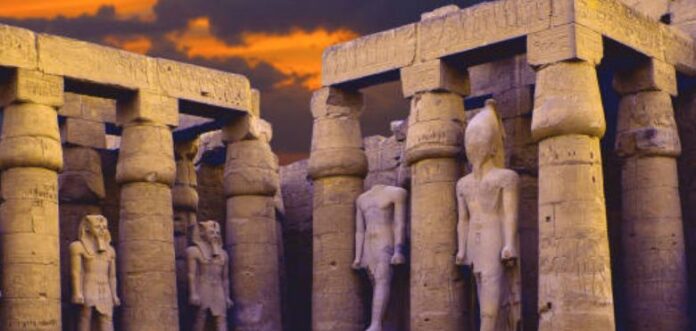Africa is loaded with the origin of humanity, as can be seen in the prehistoric paintings in African caves. These archaeological findings date back to the Stone Age. Paintings are evidence that art plays a significant role in the African continent.
Generally, Africa is known for its sculptures, paintings, textiles, and other artistic abilities. Ancient African populations used arts to express their thoughts, tell stories, educate, and preserve cultures.
A Quick Look at the Influence of Arts in Ancient Africa Regions
In northern Africa, after the Muslims conquered them, their art became influenced by the Arabs.
Also, after Christians and the Europeans conquered the horn of Africa and Ethiopia, they dominated their arts.
What’s more? The Sahara desert populations are the primary creators of present-day African art. Additionally, tombs and temples protected the arts of ancient Egypt.
Ancient African Structural Arts and Masterpieces
Egypt holds the most well-known masterpieces and monumental artistic sculptures across ancient Africa.
Abu Simbel’s giant pharaohs, pyramids, temples, sphinx, among many other statues and structures, are evidence of their significant influence.
Similarly, Ethiopia’s monumental churches and pillars of Aksum and the Djene mosque in Mali, among other architectures, are of significant impact on the way people view Ancient Africa.
The Major Forms of Ancient Africa Arts
Generally, African arts have three dimensions, and this has existed from time immemorial. Below are the most famous constituents of African arts;
Ceramics: Commonly used African pots and bowls are products of fine pottery. These ceramics are made from fine clays and then given excellent artistic finishing.
Sculpture: Ancient Africa used more sculptures than paintings, as seen in the famous Nok sculpture. This primary element of ancient African art mainly came in animal or human forms made from wood, ivory, clay, and bronze.
Jewelry: Based on the availability of some rare natural resources in Africa, most ancient Africa arts come in the forms of pieces of jewelry made from shells, gold, diamonds, and so on. The type of your jewelry signifies your class.
Masks: Ancient Africans wear masks alongside other costumes while dancing in ceremonies. The principal material for making African masks is wood, adorned with feathers, ivory, and pearls.
Creatures: Most ancient Africa arts are exaggerated human forms and sometimes animals. Some of the art features faces of humans, animals, or a combination of both.
Developments in Ancient Africa Civilizations
Ancient Africa had kingdoms and empires that witnessed civilizations. These Ancient Africa populations still exist but are spread across countries in the African continent. The most popular realms are;
- The Kingdom of Zimbabwe
- Kingdom of Ghana
- Mali Empire
- The Kingdom of Mutapa
- Ancient Egypt
- Songhai Empire
- The Ethiopian Empire
- Kush
- Kingdom of Aksum
- The Kingdom of Kongo
- The Benin Empire
- Ancient Carthage
- Central African Kingdoms
Some remarkable Facts about Ancient Africa
- The daily life of typical ancient Africans is doing jobs like farming, trading, blacksmithing, fighting wars, and slavery.
- The traditional religious belief of Ancient Africans is on nature spirits, ancestral spirits, supreme gods, magic, and rituals.
- Paintings in Namibia rocks are one of the oldest globally, believed to be close to 20 thousand years old.
- The major religions in Africa are Christian religion, Islamic religion, and traditional African religions.
How Has African Art Influenced The World?
Slave trade and colonization gave way for African arts to influence the world. The primary element of African art includes masks, paintings, sculptures, textiles, ivory, and human forms, among other kinds.
Artists from across the globe who have had contact with Africa art draw their inspiration from it and spread them across Europe, the United States, and others.
What Role Did Art Play in African History?
Through storytelling, painting, and other artistic means, cultures, and traditions passed to generations in Africa.
These are great forms of art that make up African history. Also, art plays a vital role via the popular Africa masks or masquerades used in communicating with the spirits to date.
What culture heavily influenced the art of ancient Africa?
A couple of cultures influenced ancient Africa from the 19th century during the penetrations of foreigners to Africa.
However, the Arab culture seems to have more impact on the art of ancient Africa. Another culture that affected the arts of ancient Africa is the European culture.
Who was influenced by African art?
A couple of artists from the Western part of Africa experience the influence of African arts. It is evident in their concepts which draw inspiration from Africa.
The artists with the most influence on African art are Modigliani, Derain, Vlaminck, and Picasso.
Conclusion
During the 19th century, Europeans and religious groups penetrated ancient Africa, making African arts popular.
Indeed, art is an expression of human thoughts and feelings with the use of available materials. Therefore, artists draw inspiration from their immediate environments, of which ancient African art is no exception.


